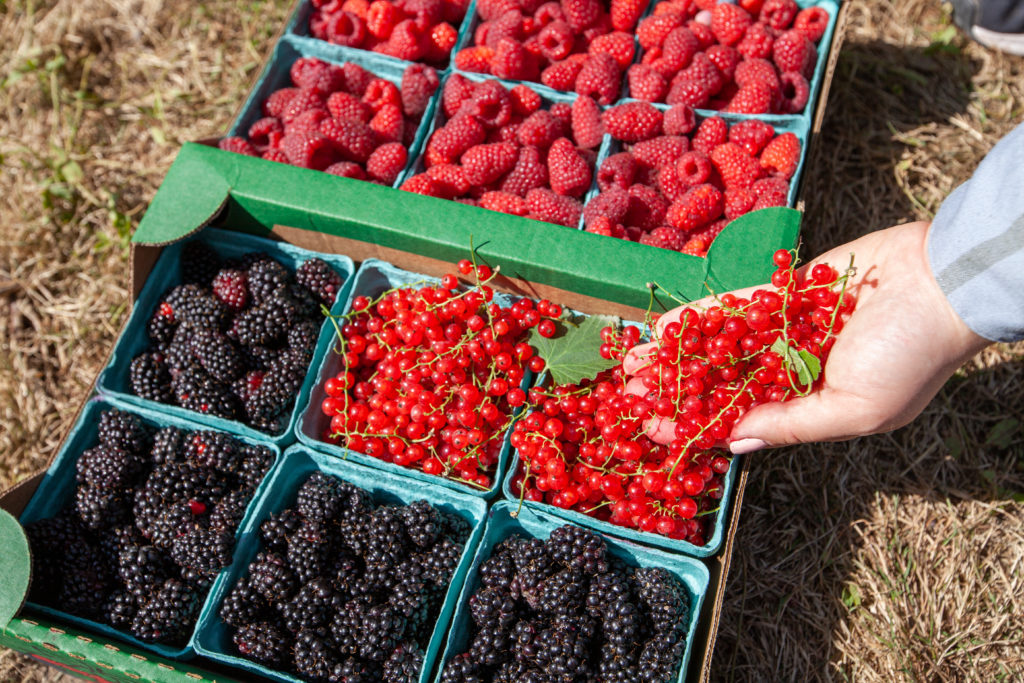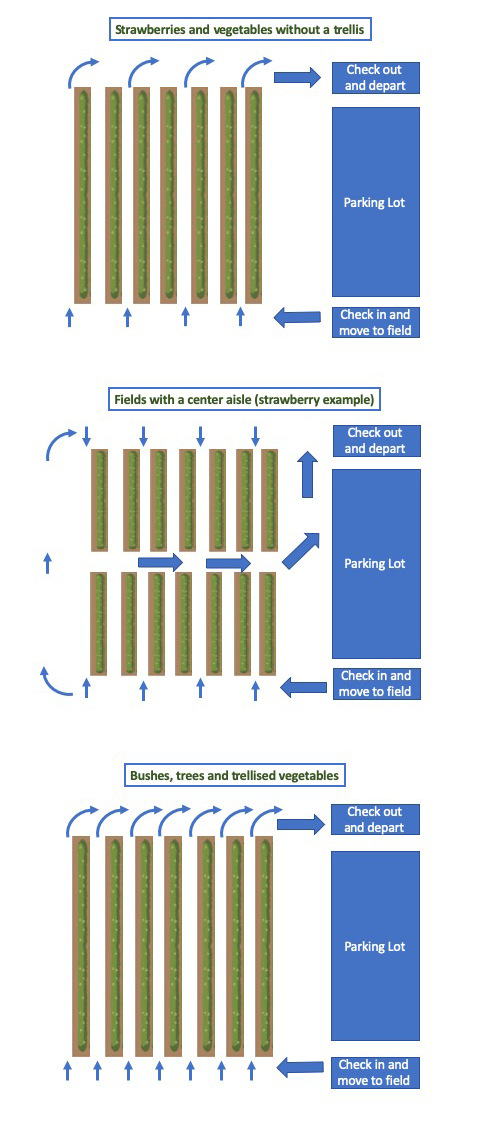

May 13, 2020Navigating U-picks in the COVID-19 pandemic
Growers in April took some careful first steps to navigate pick-your-own enterprises during the COVID-19 pandemic.
By April, pick-your-own seasons had already begun in the South for strawberries. Traditional pick-your-own seasons for a variety of crops in different regions will stretch on for months – for instance, the Northwest apple season can stretch to the end of October.
Since quarantine orders and infection levels varied by state and locality – and since they would likely change over the next 12 months – a definitive, detailed pick-your-own policy for the whole country was elusive.
However, Extension educators did begin, in April to suggest some tactics for minimizing risk at U-picks and to share what other growers in other areas were trying. Here are some of those ideas and anecdotes:
Communicate with customers
“Never before has communication been as critical as it is now,” according to an article from the Cornell Small Farms Program. “Before customers arrive on the farm, share the proactive steps you will take to protect their health and safety and the need to work together during this time.”
Growers are urged to use websites, social media, phone messages, farm signage, newsletters, newspaper ads any other means to reach customers, according to Cornell. Customers should be told not to come to the farm if they have symptoms of COVID-19 or any other contagious illness, or if they’ve been in contact with someone who has. Tell them if they do show up with symptoms, they will be asked to leave. Remind them to wear cloth face coverings or other personal protection equipment (PPE). And prepare them for the new flow of operations at the berry patch or orchard – new entrances, parking spaces, washing stations and new rules.
Pivoting online
Some growers may find it necessary to cancel their pick-your-own service for the year, and move their sales to another venue. For instance, in Michigan, in late April, U-picks as an activity were not allowed, while the berries as food were still deemed “essential” by authorities, and thus could be sold in other ways.
In a Michigan State University (MSU) webinar for growers, Jae Gerhart, MSU Extension local foods coordinator, said growers may instead find it better to distribute their fruit through a delivery service, existing Community Supported Agriculture programs or online marketplaces such as Farmigo, Harvie, Barn2Door, Open Food Network or Local Food Marketplace. She also recommended getting your farm market listed on any buy-local websites such as MarketMaker.
MSU Community Food Systems Educator Garrett Ziegler encouraged growers to think strategically about their farm market.
“If you have a farm market, it gets limited in the amount of space you have in there, so maybe it gets limited in the number of the customers you can have coming in there, and still being able to maintain those social distancing regulations,” he said. “If you have additional outdoor space, maybe set up some pop-up tents, areas where you can have people doing some pre-ordering.” He said it’s also helpful to have as much product pre-packaged as possible.
Rethink the customer flow


Some Extension personnel are advising to have pick-your-own customers placed every other row (especially in strawberries or vegetables), and assigned to a specific section in a sort of grid or block system.
Growers are encouraged to lay things out so that there is a one-direction of foot traffic from registration, through the berry patch or orchard to checkout. Growers could require signing up ahead of time, even requiring refundable deposits. The Cornell Small Farms Program advised growers to think about limiting the number of people at the farm at any one time, and possibly designating specific hours for individuals who are the most vulnerable to COVID-19 infection, such as the elderly or those with compromised immune systems.
Several Extension agents also advised eliminating music, picnic tables or any promotions that could encourage customers to congregate on the site.
Sanitation at the cash register. Several Extension representatives and growers recommended giving customers cheap, new buckets or pint containers that they could take home with them – this is a way to avoid cross-contamination from a scale or re-useable containers.
Mark Hoffman of North Carolina State Extension advised in an article to strawberry growers that preventative measures could extend to the point of sale.
“If cash is used, your employees need to wear gloves and hand-sanitize after every transaction!” according to the article. He advised growers to consider cash-less money transfers such as cards or online transfers including PayPal or Facebook Marketplace. Gerhart, of MSU Extension, said many growers recommend Square for processing payments, because, she said, there are fewer middlemen involved.
Supply sanitation stations
Michelle Jacokes, a produce safety technician for the Michigan On-Farm Produce Safety Program, said that hand-washing stations should always be available for customers, but now is an even more important time to emphasize and increase handwashing.
Handwashing stations – some with no-hands foot-pumps for dispersing water – can be rented, often from the same contractors who provide port-a-potties. Other growers have found ways to build them with tables, five-gallon tanks with plastic spigots, buckets to catch the used water, soap, paper towels and a trash can.
In North Carolina, “a farmer mentioned that he has an employee stationed at hand-washing stations to have everyone that’s visiting their farm wash their hands before they’re even issued a pick bucket,” Jacokes said. “So that’s really good. If you don’t even have that, you can use signage to encourage people.”
Track employee health
The University of Florida’s Institute of Food and Agricultural Sciences Extension in a published article advised growers to closely track employee health.
“Businesses should follow CDC (Centers for Disease Control) and FDA Food and Drug Administration guidance for screening employees who have been exposed to COVID-19,” they said. “Pre-screen employees for symptoms or fever before t starting work. Employees with fever and symptoms should be advised to see a doctor for evaluation and should be deferred to Human Resources for next steps.”
MSU Senior Extension Educator Ron Goldy responded to a question about how to react if an employee is diagnosed with COVID-19 or shows symptoms:
“The worker goes home of course, and stays home for a while,” he said. “The question probably leads to tracing people that that person has come into contact with. … And I don’t know how you would trace all the customers who have come in contact with. You could trace employees, but I don’t know what the regulations are for making a public announcement saying ‘Our farm had a problem’ – that’s not very good.”
Phil Tocco, an MSU Extension food safety educator, added that in such a circumstance, a grower should consider where the employee had been working and make sure surfaces were disinfected.
“There’s actually some really good guidelines, put out by United Fresh and the Produce Marketing Association about what to do in situations where you had a worker test positive, or a worker showing symptoms,” he said.
– Stephen Kloosterman, associate editor














